Analysis of Leadership and Management in Soft Company Operations
VerifiedAdded on 2023/01/12
|15
|4894
|71
Report
AI Summary
This report provides a comprehensive analysis of leadership and management principles within the context of Soft Company's operations. It begins by differentiating between the roles and characteristics of leaders and managers, examining how these roles apply in various situational contexts. The report then delves into the leadership style of Joan Pearson and evaluates the application of situational, system, and contingency leadership theories to Soft Company, assessing their suitability and effectiveness. Furthermore, it explores key approaches to operations management, emphasizing the importance of operational efficiency in achieving business objectives. The report also assesses the impact of the business environment on operational and management decisions, culminating in a critical evaluation of operations management practices and their wider implications. The report concludes with recommendations to improve Soft Company's leadership and management strategies.
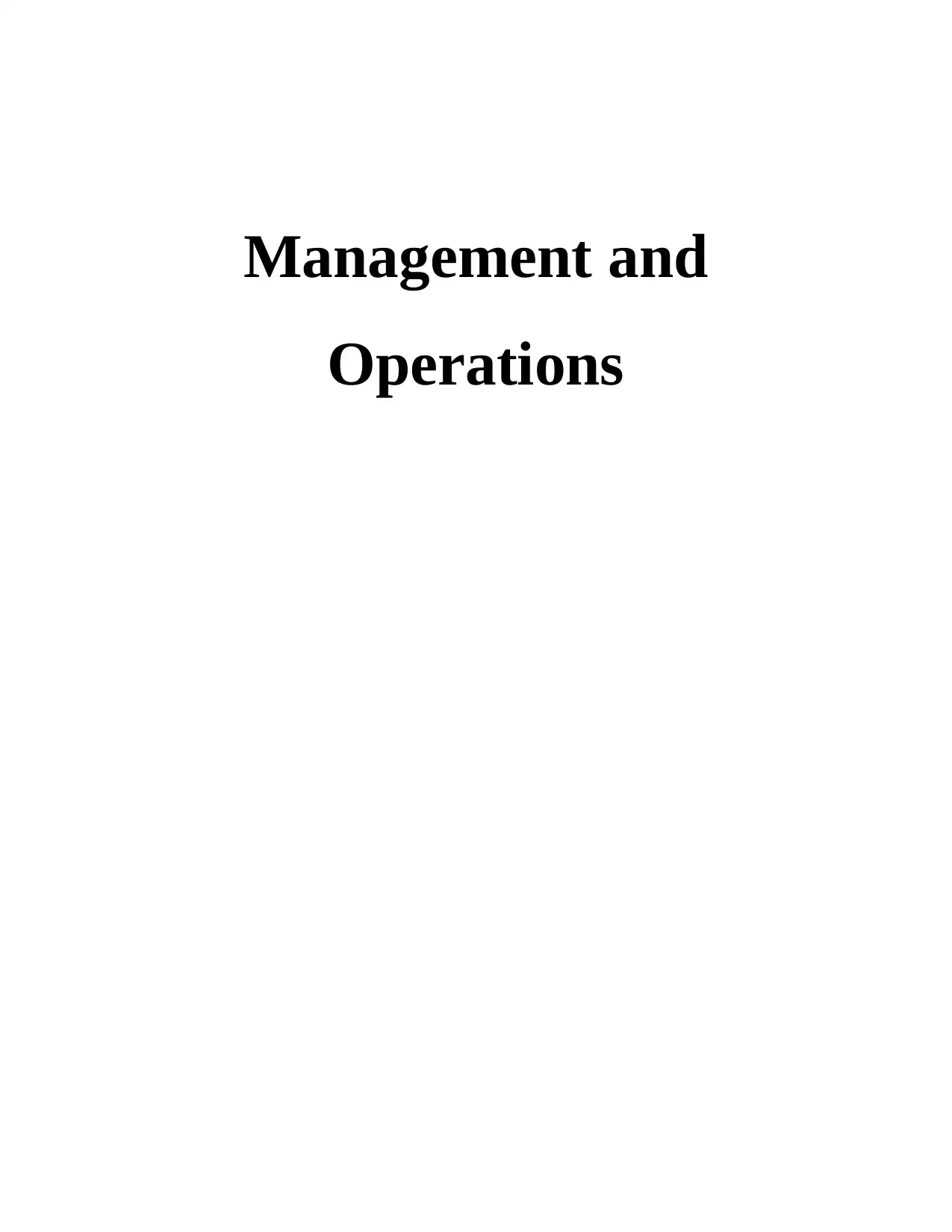
Management and
Operations
Operations
Paraphrase This Document
Need a fresh take? Get an instant paraphrase of this document with our AI Paraphraser
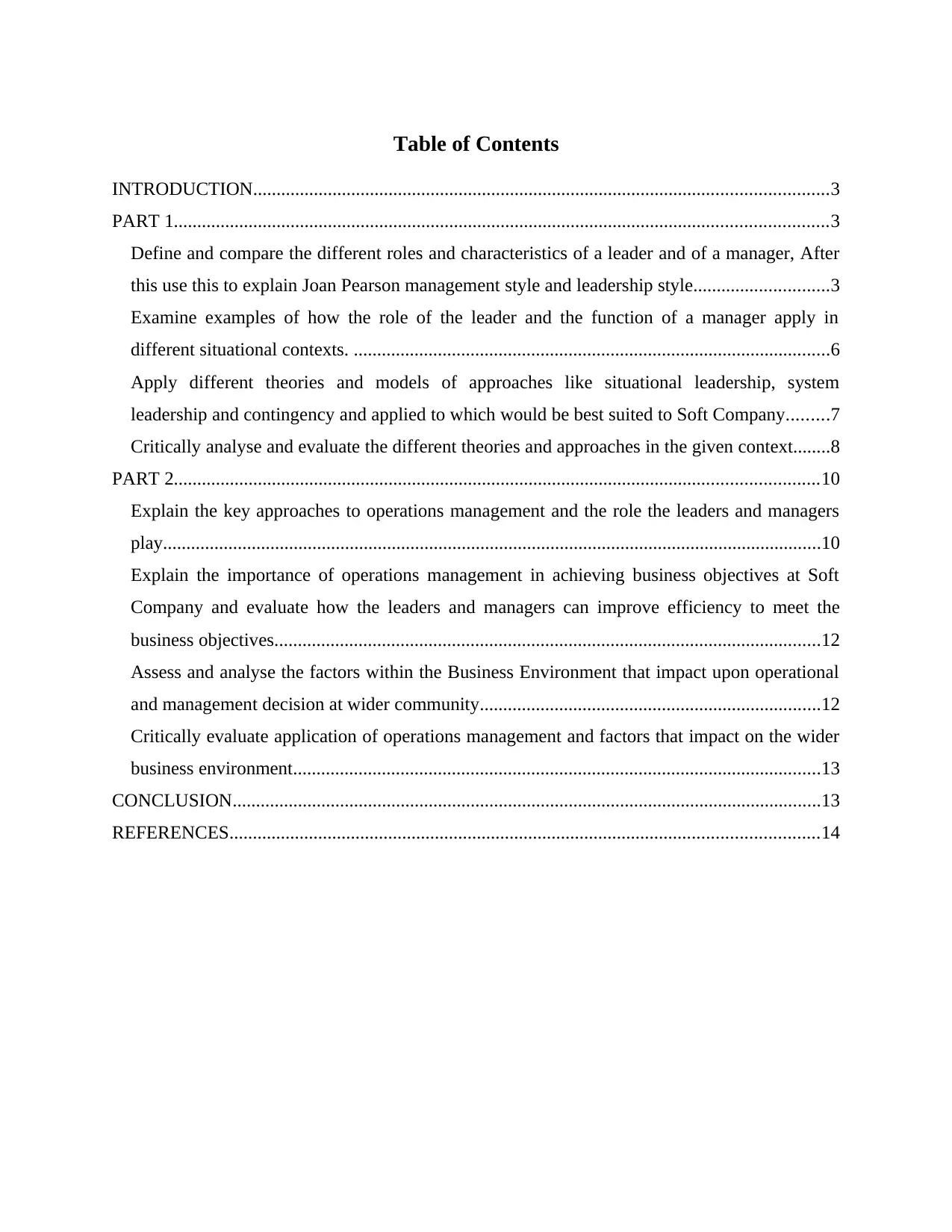
Table of Contents
INTRODUCTION...........................................................................................................................3
PART 1............................................................................................................................................3
Define and compare the different roles and characteristics of a leader and of a manager, After
this use this to explain Joan Pearson management style and leadership style.............................3
Examine examples of how the role of the leader and the function of a manager apply in
different situational contexts. ......................................................................................................6
Apply different theories and models of approaches like situational leadership, system
leadership and contingency and applied to which would be best suited to Soft Company.........7
Critically analyse and evaluate the different theories and approaches in the given context........8
PART 2..........................................................................................................................................10
Explain the key approaches to operations management and the role the leaders and managers
play.............................................................................................................................................10
Explain the importance of operations management in achieving business objectives at Soft
Company and evaluate how the leaders and managers can improve efficiency to meet the
business objectives.....................................................................................................................12
Assess and analyse the factors within the Business Environment that impact upon operational
and management decision at wider community.........................................................................12
Critically evaluate application of operations management and factors that impact on the wider
business environment.................................................................................................................13
CONCLUSION..............................................................................................................................13
REFERENCES..............................................................................................................................14
INTRODUCTION...........................................................................................................................3
PART 1............................................................................................................................................3
Define and compare the different roles and characteristics of a leader and of a manager, After
this use this to explain Joan Pearson management style and leadership style.............................3
Examine examples of how the role of the leader and the function of a manager apply in
different situational contexts. ......................................................................................................6
Apply different theories and models of approaches like situational leadership, system
leadership and contingency and applied to which would be best suited to Soft Company.........7
Critically analyse and evaluate the different theories and approaches in the given context........8
PART 2..........................................................................................................................................10
Explain the key approaches to operations management and the role the leaders and managers
play.............................................................................................................................................10
Explain the importance of operations management in achieving business objectives at Soft
Company and evaluate how the leaders and managers can improve efficiency to meet the
business objectives.....................................................................................................................12
Assess and analyse the factors within the Business Environment that impact upon operational
and management decision at wider community.........................................................................12
Critically evaluate application of operations management and factors that impact on the wider
business environment.................................................................................................................13
CONCLUSION..............................................................................................................................13
REFERENCES..............................................................................................................................14
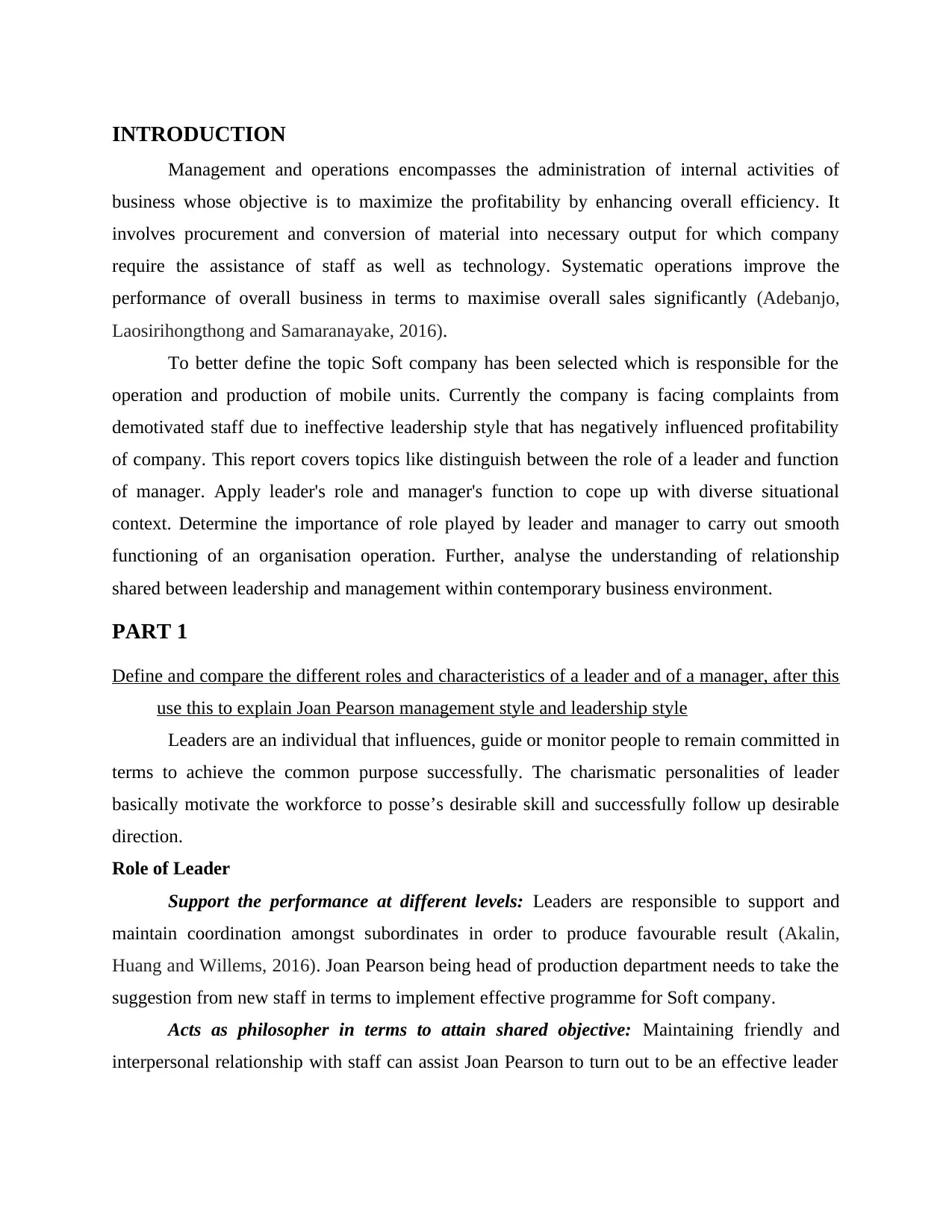
INTRODUCTION
Management and operations encompasses the administration of internal activities of
business whose objective is to maximize the profitability by enhancing overall efficiency. It
involves procurement and conversion of material into necessary output for which company
require the assistance of staff as well as technology. Systematic operations improve the
performance of overall business in terms to maximise overall sales significantly (Adebanjo,
Laosirihongthong and Samaranayake, 2016).
To better define the topic Soft company has been selected which is responsible for the
operation and production of mobile units. Currently the company is facing complaints from
demotivated staff due to ineffective leadership style that has negatively influenced profitability
of company. This report covers topics like distinguish between the role of a leader and function
of manager. Apply leader's role and manager's function to cope up with diverse situational
context. Determine the importance of role played by leader and manager to carry out smooth
functioning of an organisation operation. Further, analyse the understanding of relationship
shared between leadership and management within contemporary business environment.
PART 1
Define and compare the different roles and characteristics of a leader and of a manager, after this
use this to explain Joan Pearson management style and leadership style
Leaders are an individual that influences, guide or monitor people to remain committed in
terms to achieve the common purpose successfully. The charismatic personalities of leader
basically motivate the workforce to posse’s desirable skill and successfully follow up desirable
direction.
Role of Leader
Support the performance at different levels: Leaders are responsible to support and
maintain coordination amongst subordinates in order to produce favourable result (Akalin,
Huang and Willems, 2016). Joan Pearson being head of production department needs to take the
suggestion from new staff in terms to implement effective programme for Soft company.
Acts as philosopher in terms to attain shared objective: Maintaining friendly and
interpersonal relationship with staff can assist Joan Pearson to turn out to be an effective leader
Management and operations encompasses the administration of internal activities of
business whose objective is to maximize the profitability by enhancing overall efficiency. It
involves procurement and conversion of material into necessary output for which company
require the assistance of staff as well as technology. Systematic operations improve the
performance of overall business in terms to maximise overall sales significantly (Adebanjo,
Laosirihongthong and Samaranayake, 2016).
To better define the topic Soft company has been selected which is responsible for the
operation and production of mobile units. Currently the company is facing complaints from
demotivated staff due to ineffective leadership style that has negatively influenced profitability
of company. This report covers topics like distinguish between the role of a leader and function
of manager. Apply leader's role and manager's function to cope up with diverse situational
context. Determine the importance of role played by leader and manager to carry out smooth
functioning of an organisation operation. Further, analyse the understanding of relationship
shared between leadership and management within contemporary business environment.
PART 1
Define and compare the different roles and characteristics of a leader and of a manager, after this
use this to explain Joan Pearson management style and leadership style
Leaders are an individual that influences, guide or monitor people to remain committed in
terms to achieve the common purpose successfully. The charismatic personalities of leader
basically motivate the workforce to posse’s desirable skill and successfully follow up desirable
direction.
Role of Leader
Support the performance at different levels: Leaders are responsible to support and
maintain coordination amongst subordinates in order to produce favourable result (Akalin,
Huang and Willems, 2016). Joan Pearson being head of production department needs to take the
suggestion from new staff in terms to implement effective programme for Soft company.
Acts as philosopher in terms to attain shared objective: Maintaining friendly and
interpersonal relationship with staff can assist Joan Pearson to turn out to be an effective leader
⊘ This is a preview!⊘
Do you want full access?
Subscribe today to unlock all pages.

Trusted by 1+ million students worldwide
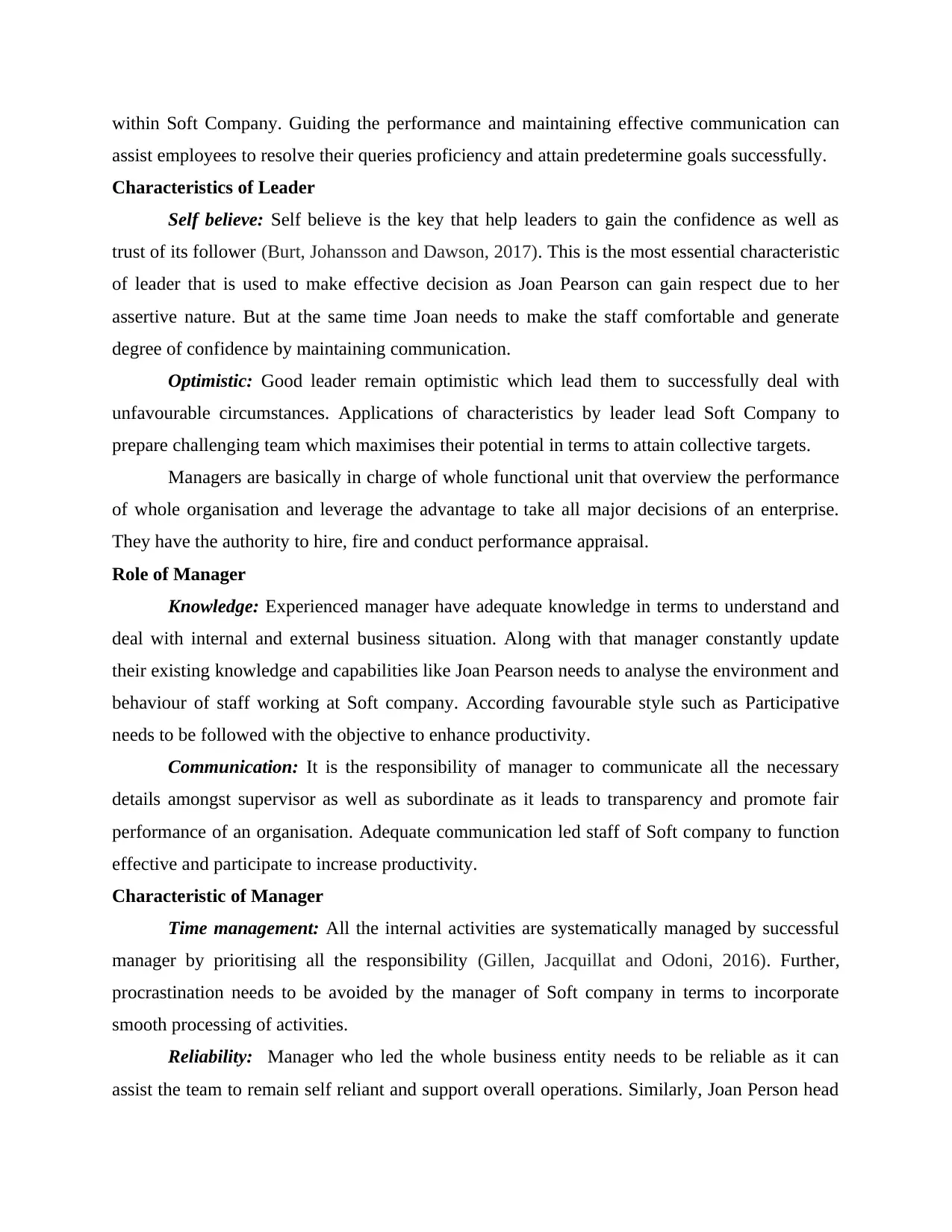
within Soft Company. Guiding the performance and maintaining effective communication can
assist employees to resolve their queries proficiency and attain predetermine goals successfully.
Characteristics of Leader
Self believe: Self believe is the key that help leaders to gain the confidence as well as
trust of its follower (Burt, Johansson and Dawson, 2017). This is the most essential characteristic
of leader that is used to make effective decision as Joan Pearson can gain respect due to her
assertive nature. But at the same time Joan needs to make the staff comfortable and generate
degree of confidence by maintaining communication.
Optimistic: Good leader remain optimistic which lead them to successfully deal with
unfavourable circumstances. Applications of characteristics by leader lead Soft Company to
prepare challenging team which maximises their potential in terms to attain collective targets.
Managers are basically in charge of whole functional unit that overview the performance
of whole organisation and leverage the advantage to take all major decisions of an enterprise.
They have the authority to hire, fire and conduct performance appraisal.
Role of Manager
Knowledge: Experienced manager have adequate knowledge in terms to understand and
deal with internal and external business situation. Along with that manager constantly update
their existing knowledge and capabilities like Joan Pearson needs to analyse the environment and
behaviour of staff working at Soft company. According favourable style such as Participative
needs to be followed with the objective to enhance productivity.
Communication: It is the responsibility of manager to communicate all the necessary
details amongst supervisor as well as subordinate as it leads to transparency and promote fair
performance of an organisation. Adequate communication led staff of Soft company to function
effective and participate to increase productivity.
Characteristic of Manager
Time management: All the internal activities are systematically managed by successful
manager by prioritising all the responsibility (Gillen, Jacquillat and Odoni, 2016). Further,
procrastination needs to be avoided by the manager of Soft company in terms to incorporate
smooth processing of activities.
Reliability: Manager who led the whole business entity needs to be reliable as it can
assist the team to remain self reliant and support overall operations. Similarly, Joan Person head
assist employees to resolve their queries proficiency and attain predetermine goals successfully.
Characteristics of Leader
Self believe: Self believe is the key that help leaders to gain the confidence as well as
trust of its follower (Burt, Johansson and Dawson, 2017). This is the most essential characteristic
of leader that is used to make effective decision as Joan Pearson can gain respect due to her
assertive nature. But at the same time Joan needs to make the staff comfortable and generate
degree of confidence by maintaining communication.
Optimistic: Good leader remain optimistic which lead them to successfully deal with
unfavourable circumstances. Applications of characteristics by leader lead Soft Company to
prepare challenging team which maximises their potential in terms to attain collective targets.
Managers are basically in charge of whole functional unit that overview the performance
of whole organisation and leverage the advantage to take all major decisions of an enterprise.
They have the authority to hire, fire and conduct performance appraisal.
Role of Manager
Knowledge: Experienced manager have adequate knowledge in terms to understand and
deal with internal and external business situation. Along with that manager constantly update
their existing knowledge and capabilities like Joan Pearson needs to analyse the environment and
behaviour of staff working at Soft company. According favourable style such as Participative
needs to be followed with the objective to enhance productivity.
Communication: It is the responsibility of manager to communicate all the necessary
details amongst supervisor as well as subordinate as it leads to transparency and promote fair
performance of an organisation. Adequate communication led staff of Soft company to function
effective and participate to increase productivity.
Characteristic of Manager
Time management: All the internal activities are systematically managed by successful
manager by prioritising all the responsibility (Gillen, Jacquillat and Odoni, 2016). Further,
procrastination needs to be avoided by the manager of Soft company in terms to incorporate
smooth processing of activities.
Reliability: Manager who led the whole business entity needs to be reliable as it can
assist the team to remain self reliant and support overall operations. Similarly, Joan Person head
Paraphrase This Document
Need a fresh take? Get an instant paraphrase of this document with our AI Paraphraser
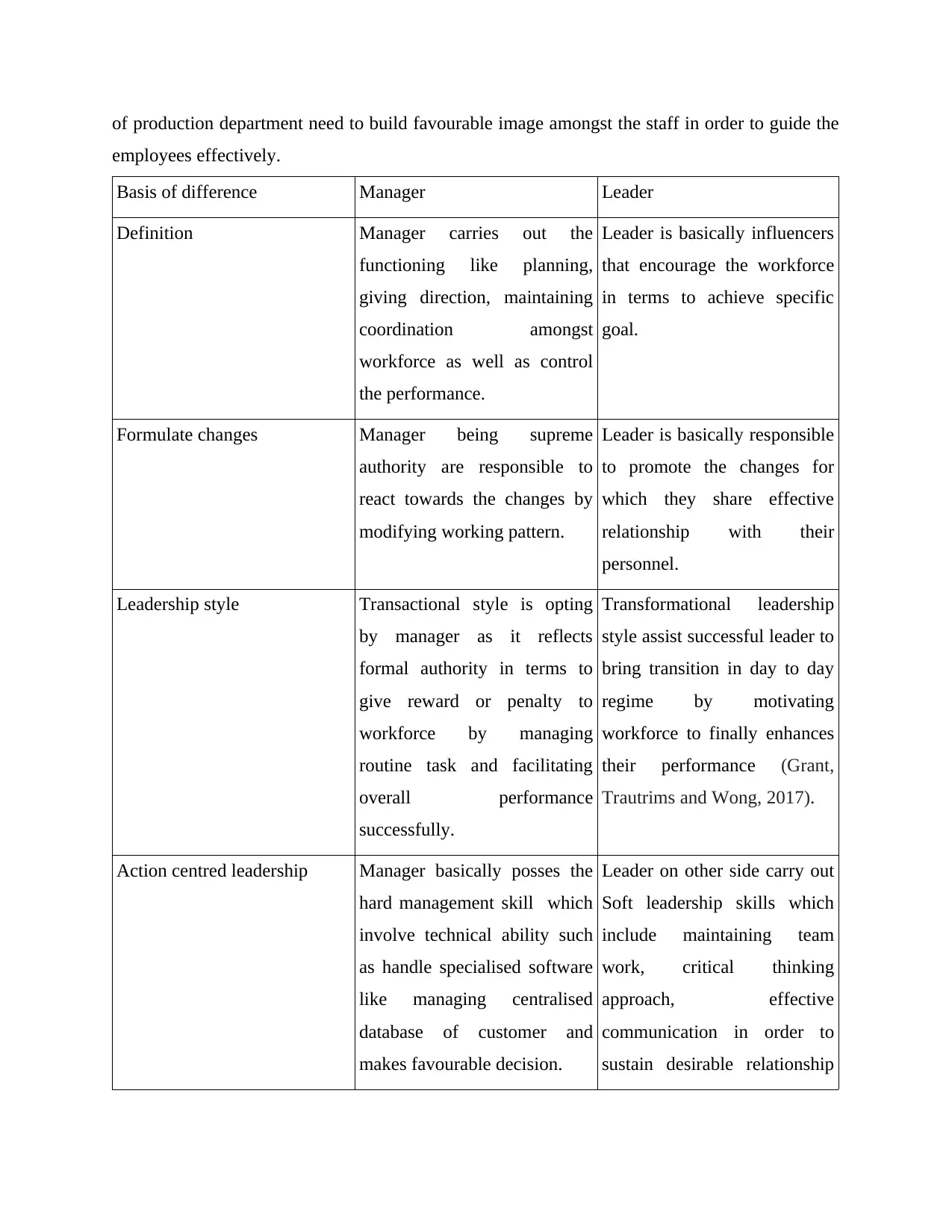
of production department need to build favourable image amongst the staff in order to guide the
employees effectively.
Basis of difference Manager Leader
Definition Manager carries out the
functioning like planning,
giving direction, maintaining
coordination amongst
workforce as well as control
the performance.
Leader is basically influencers
that encourage the workforce
in terms to achieve specific
goal.
Formulate changes Manager being supreme
authority are responsible to
react towards the changes by
modifying working pattern.
Leader is basically responsible
to promote the changes for
which they share effective
relationship with their
personnel.
Leadership style Transactional style is opting
by manager as it reflects
formal authority in terms to
give reward or penalty to
workforce by managing
routine task and facilitating
overall performance
successfully.
Transformational leadership
style assist successful leader to
bring transition in day to day
regime by motivating
workforce to finally enhances
their performance (Grant,
Trautrims and Wong, 2017).
Action centred leadership Manager basically posses the
hard management skill which
involve technical ability such
as handle specialised software
like managing centralised
database of customer and
makes favourable decision.
Leader on other side carry out
Soft leadership skills which
include maintaining team
work, critical thinking
approach, effective
communication in order to
sustain desirable relationship
employees effectively.
Basis of difference Manager Leader
Definition Manager carries out the
functioning like planning,
giving direction, maintaining
coordination amongst
workforce as well as control
the performance.
Leader is basically influencers
that encourage the workforce
in terms to achieve specific
goal.
Formulate changes Manager being supreme
authority are responsible to
react towards the changes by
modifying working pattern.
Leader is basically responsible
to promote the changes for
which they share effective
relationship with their
personnel.
Leadership style Transactional style is opting
by manager as it reflects
formal authority in terms to
give reward or penalty to
workforce by managing
routine task and facilitating
overall performance
successfully.
Transformational leadership
style assist successful leader to
bring transition in day to day
regime by motivating
workforce to finally enhances
their performance (Grant,
Trautrims and Wong, 2017).
Action centred leadership Manager basically posses the
hard management skill which
involve technical ability such
as handle specialised software
like managing centralised
database of customer and
makes favourable decision.
Leader on other side carry out
Soft leadership skills which
include maintaining team
work, critical thinking
approach, effective
communication in order to
sustain desirable relationship
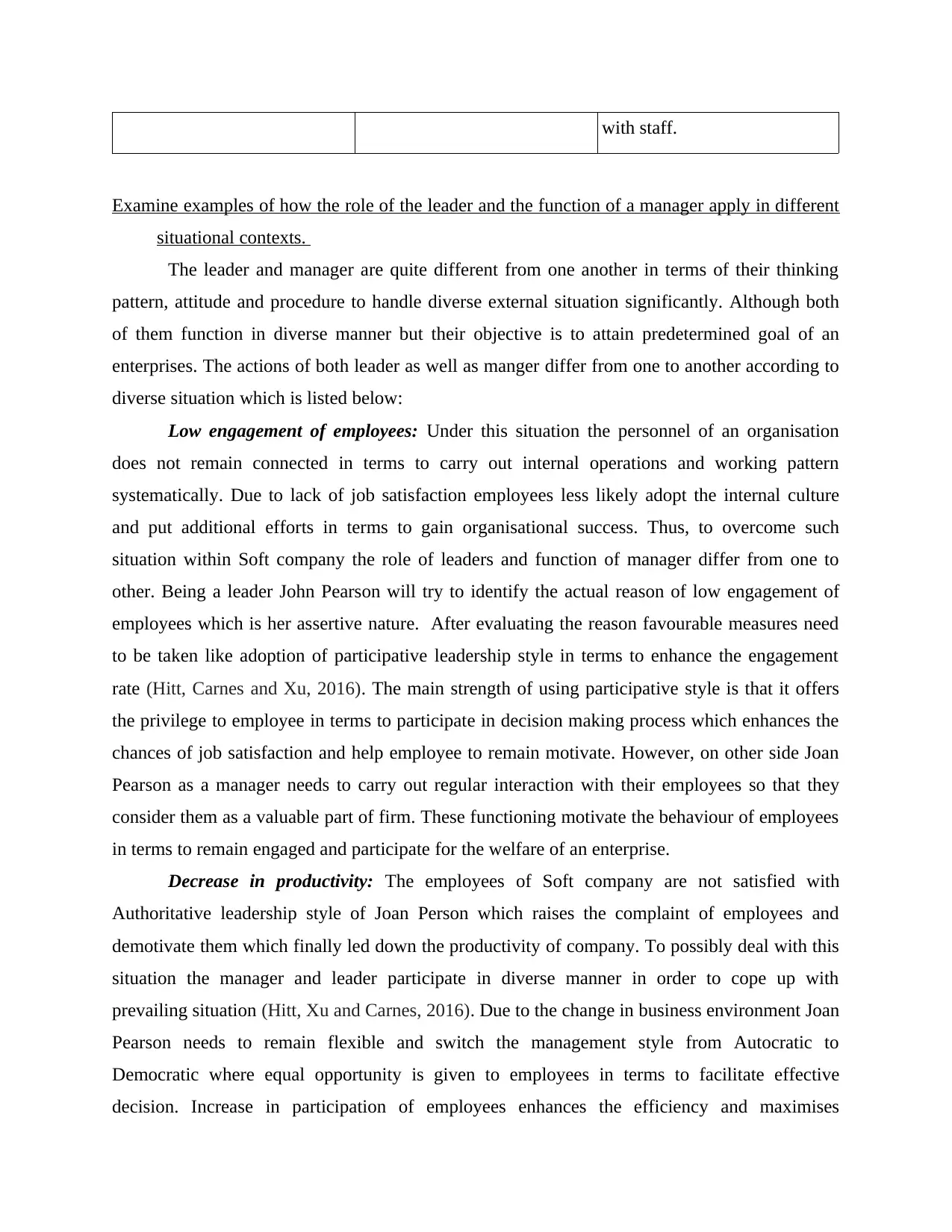
with staff.
Examine examples of how the role of the leader and the function of a manager apply in different
situational contexts.
The leader and manager are quite different from one another in terms of their thinking
pattern, attitude and procedure to handle diverse external situation significantly. Although both
of them function in diverse manner but their objective is to attain predetermined goal of an
enterprises. The actions of both leader as well as manger differ from one to another according to
diverse situation which is listed below:
Low engagement of employees: Under this situation the personnel of an organisation
does not remain connected in terms to carry out internal operations and working pattern
systematically. Due to lack of job satisfaction employees less likely adopt the internal culture
and put additional efforts in terms to gain organisational success. Thus, to overcome such
situation within Soft company the role of leaders and function of manager differ from one to
other. Being a leader John Pearson will try to identify the actual reason of low engagement of
employees which is her assertive nature. After evaluating the reason favourable measures need
to be taken like adoption of participative leadership style in terms to enhance the engagement
rate (Hitt, Carnes and Xu, 2016). The main strength of using participative style is that it offers
the privilege to employee in terms to participate in decision making process which enhances the
chances of job satisfaction and help employee to remain motivate. However, on other side Joan
Pearson as a manager needs to carry out regular interaction with their employees so that they
consider them as a valuable part of firm. These functioning motivate the behaviour of employees
in terms to remain engaged and participate for the welfare of an enterprise.
Decrease in productivity: The employees of Soft company are not satisfied with
Authoritative leadership style of Joan Person which raises the complaint of employees and
demotivate them which finally led down the productivity of company. To possibly deal with this
situation the manager and leader participate in diverse manner in order to cope up with
prevailing situation (Hitt, Xu and Carnes, 2016). Due to the change in business environment Joan
Pearson needs to remain flexible and switch the management style from Autocratic to
Democratic where equal opportunity is given to employees in terms to facilitate effective
decision. Increase in participation of employees enhances the efficiency and maximises
Examine examples of how the role of the leader and the function of a manager apply in different
situational contexts.
The leader and manager are quite different from one another in terms of their thinking
pattern, attitude and procedure to handle diverse external situation significantly. Although both
of them function in diverse manner but their objective is to attain predetermined goal of an
enterprises. The actions of both leader as well as manger differ from one to another according to
diverse situation which is listed below:
Low engagement of employees: Under this situation the personnel of an organisation
does not remain connected in terms to carry out internal operations and working pattern
systematically. Due to lack of job satisfaction employees less likely adopt the internal culture
and put additional efforts in terms to gain organisational success. Thus, to overcome such
situation within Soft company the role of leaders and function of manager differ from one to
other. Being a leader John Pearson will try to identify the actual reason of low engagement of
employees which is her assertive nature. After evaluating the reason favourable measures need
to be taken like adoption of participative leadership style in terms to enhance the engagement
rate (Hitt, Carnes and Xu, 2016). The main strength of using participative style is that it offers
the privilege to employee in terms to participate in decision making process which enhances the
chances of job satisfaction and help employee to remain motivate. However, on other side Joan
Pearson as a manager needs to carry out regular interaction with their employees so that they
consider them as a valuable part of firm. These functioning motivate the behaviour of employees
in terms to remain engaged and participate for the welfare of an enterprise.
Decrease in productivity: The employees of Soft company are not satisfied with
Authoritative leadership style of Joan Person which raises the complaint of employees and
demotivate them which finally led down the productivity of company. To possibly deal with this
situation the manager and leader participate in diverse manner in order to cope up with
prevailing situation (Hitt, Xu and Carnes, 2016). Due to the change in business environment Joan
Pearson needs to remain flexible and switch the management style from Autocratic to
Democratic where equal opportunity is given to employees in terms to facilitate effective
decision. Increase in participation of employees enhances the efficiency and maximises
⊘ This is a preview!⊘
Do you want full access?
Subscribe today to unlock all pages.

Trusted by 1+ million students worldwide
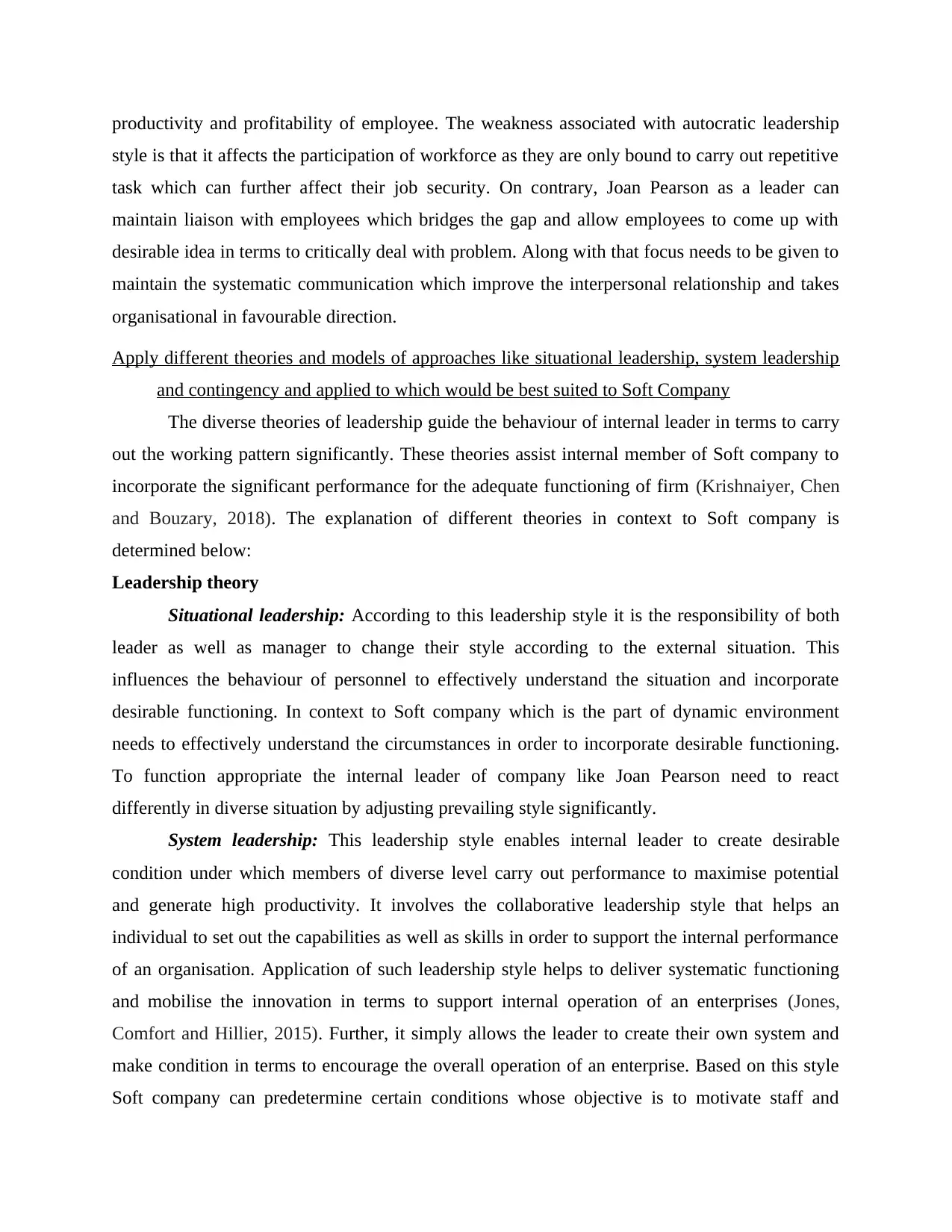
productivity and profitability of employee. The weakness associated with autocratic leadership
style is that it affects the participation of workforce as they are only bound to carry out repetitive
task which can further affect their job security. On contrary, Joan Pearson as a leader can
maintain liaison with employees which bridges the gap and allow employees to come up with
desirable idea in terms to critically deal with problem. Along with that focus needs to be given to
maintain the systematic communication which improve the interpersonal relationship and takes
organisational in favourable direction.
Apply different theories and models of approaches like situational leadership, system leadership
and contingency and applied to which would be best suited to Soft Company
The diverse theories of leadership guide the behaviour of internal leader in terms to carry
out the working pattern significantly. These theories assist internal member of Soft company to
incorporate the significant performance for the adequate functioning of firm (Krishnaiyer, Chen
and Bouzary, 2018). The explanation of different theories in context to Soft company is
determined below:
Leadership theory
Situational leadership: According to this leadership style it is the responsibility of both
leader as well as manager to change their style according to the external situation. This
influences the behaviour of personnel to effectively understand the situation and incorporate
desirable functioning. In context to Soft company which is the part of dynamic environment
needs to effectively understand the circumstances in order to incorporate desirable functioning.
To function appropriate the internal leader of company like Joan Pearson need to react
differently in diverse situation by adjusting prevailing style significantly.
System leadership: This leadership style enables internal leader to create desirable
condition under which members of diverse level carry out performance to maximise potential
and generate high productivity. It involves the collaborative leadership style that helps an
individual to set out the capabilities as well as skills in order to support the internal performance
of an organisation. Application of such leadership style helps to deliver systematic functioning
and mobilise the innovation in terms to support internal operation of an enterprises (Jones,
Comfort and Hillier, 2015). Further, it simply allows the leader to create their own system and
make condition in terms to encourage the overall operation of an enterprise. Based on this style
Soft company can predetermine certain conditions whose objective is to motivate staff and
style is that it affects the participation of workforce as they are only bound to carry out repetitive
task which can further affect their job security. On contrary, Joan Pearson as a leader can
maintain liaison with employees which bridges the gap and allow employees to come up with
desirable idea in terms to critically deal with problem. Along with that focus needs to be given to
maintain the systematic communication which improve the interpersonal relationship and takes
organisational in favourable direction.
Apply different theories and models of approaches like situational leadership, system leadership
and contingency and applied to which would be best suited to Soft Company
The diverse theories of leadership guide the behaviour of internal leader in terms to carry
out the working pattern significantly. These theories assist internal member of Soft company to
incorporate the significant performance for the adequate functioning of firm (Krishnaiyer, Chen
and Bouzary, 2018). The explanation of different theories in context to Soft company is
determined below:
Leadership theory
Situational leadership: According to this leadership style it is the responsibility of both
leader as well as manager to change their style according to the external situation. This
influences the behaviour of personnel to effectively understand the situation and incorporate
desirable functioning. In context to Soft company which is the part of dynamic environment
needs to effectively understand the circumstances in order to incorporate desirable functioning.
To function appropriate the internal leader of company like Joan Pearson need to react
differently in diverse situation by adjusting prevailing style significantly.
System leadership: This leadership style enables internal leader to create desirable
condition under which members of diverse level carry out performance to maximise potential
and generate high productivity. It involves the collaborative leadership style that helps an
individual to set out the capabilities as well as skills in order to support the internal performance
of an organisation. Application of such leadership style helps to deliver systematic functioning
and mobilise the innovation in terms to support internal operation of an enterprises (Jones,
Comfort and Hillier, 2015). Further, it simply allows the leader to create their own system and
make condition in terms to encourage the overall operation of an enterprise. Based on this style
Soft company can predetermine certain conditions whose objective is to motivate staff and
Paraphrase This Document
Need a fresh take? Get an instant paraphrase of this document with our AI Paraphraser
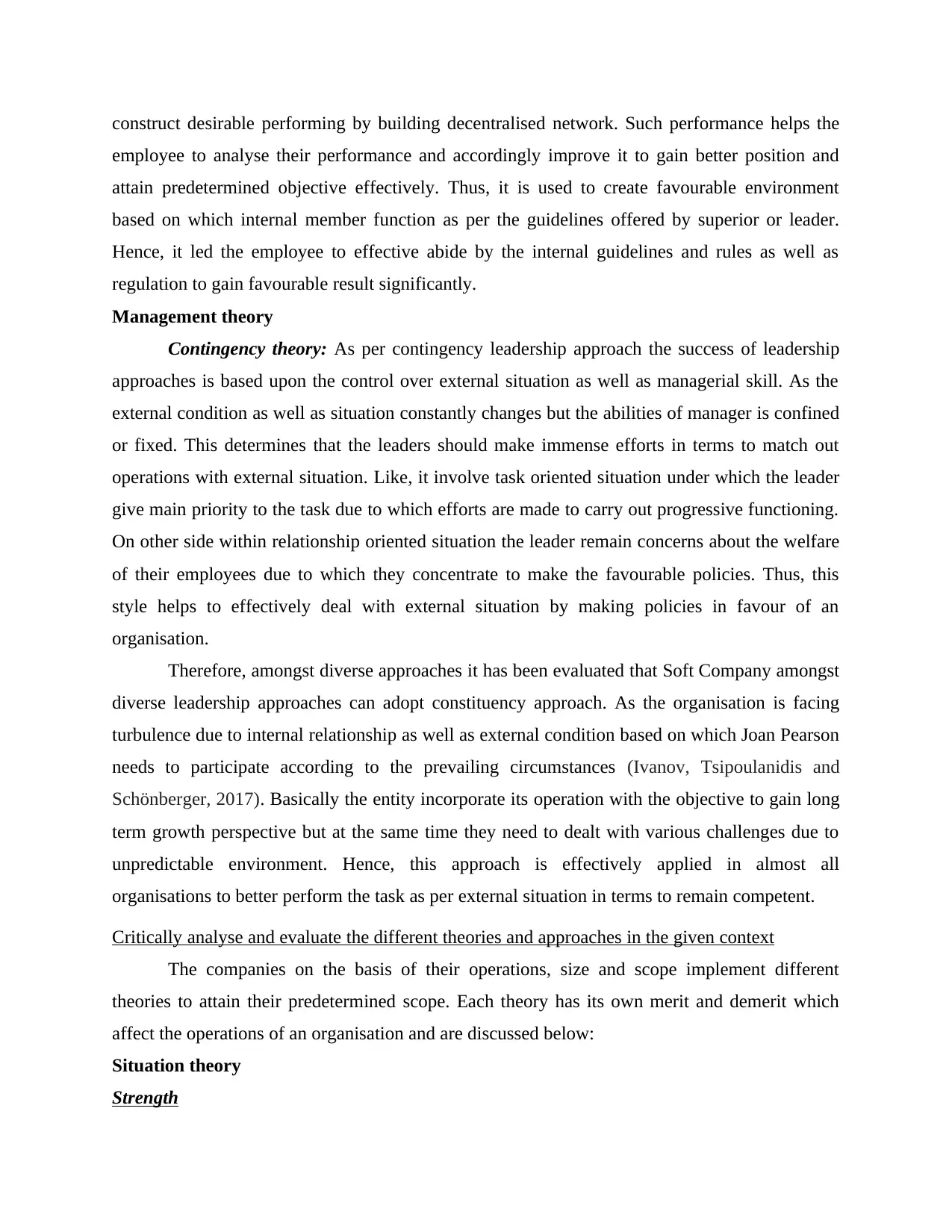
construct desirable performing by building decentralised network. Such performance helps the
employee to analyse their performance and accordingly improve it to gain better position and
attain predetermined objective effectively. Thus, it is used to create favourable environment
based on which internal member function as per the guidelines offered by superior or leader.
Hence, it led the employee to effective abide by the internal guidelines and rules as well as
regulation to gain favourable result significantly.
Management theory
Contingency theory: As per contingency leadership approach the success of leadership
approaches is based upon the control over external situation as well as managerial skill. As the
external condition as well as situation constantly changes but the abilities of manager is confined
or fixed. This determines that the leaders should make immense efforts in terms to match out
operations with external situation. Like, it involve task oriented situation under which the leader
give main priority to the task due to which efforts are made to carry out progressive functioning.
On other side within relationship oriented situation the leader remain concerns about the welfare
of their employees due to which they concentrate to make the favourable policies. Thus, this
style helps to effectively deal with external situation by making policies in favour of an
organisation.
Therefore, amongst diverse approaches it has been evaluated that Soft Company amongst
diverse leadership approaches can adopt constituency approach. As the organisation is facing
turbulence due to internal relationship as well as external condition based on which Joan Pearson
needs to participate according to the prevailing circumstances (Ivanov, Tsipoulanidis and
Schönberger, 2017). Basically the entity incorporate its operation with the objective to gain long
term growth perspective but at the same time they need to dealt with various challenges due to
unpredictable environment. Hence, this approach is effectively applied in almost all
organisations to better perform the task as per external situation in terms to remain competent.
Critically analyse and evaluate the different theories and approaches in the given context
The companies on the basis of their operations, size and scope implement different
theories to attain their predetermined scope. Each theory has its own merit and demerit which
affect the operations of an organisation and are discussed below:
Situation theory
Strength
employee to analyse their performance and accordingly improve it to gain better position and
attain predetermined objective effectively. Thus, it is used to create favourable environment
based on which internal member function as per the guidelines offered by superior or leader.
Hence, it led the employee to effective abide by the internal guidelines and rules as well as
regulation to gain favourable result significantly.
Management theory
Contingency theory: As per contingency leadership approach the success of leadership
approaches is based upon the control over external situation as well as managerial skill. As the
external condition as well as situation constantly changes but the abilities of manager is confined
or fixed. This determines that the leaders should make immense efforts in terms to match out
operations with external situation. Like, it involve task oriented situation under which the leader
give main priority to the task due to which efforts are made to carry out progressive functioning.
On other side within relationship oriented situation the leader remain concerns about the welfare
of their employees due to which they concentrate to make the favourable policies. Thus, this
style helps to effectively deal with external situation by making policies in favour of an
organisation.
Therefore, amongst diverse approaches it has been evaluated that Soft Company amongst
diverse leadership approaches can adopt constituency approach. As the organisation is facing
turbulence due to internal relationship as well as external condition based on which Joan Pearson
needs to participate according to the prevailing circumstances (Ivanov, Tsipoulanidis and
Schönberger, 2017). Basically the entity incorporate its operation with the objective to gain long
term growth perspective but at the same time they need to dealt with various challenges due to
unpredictable environment. Hence, this approach is effectively applied in almost all
organisations to better perform the task as per external situation in terms to remain competent.
Critically analyse and evaluate the different theories and approaches in the given context
The companies on the basis of their operations, size and scope implement different
theories to attain their predetermined scope. Each theory has its own merit and demerit which
affect the operations of an organisation and are discussed below:
Situation theory
Strength
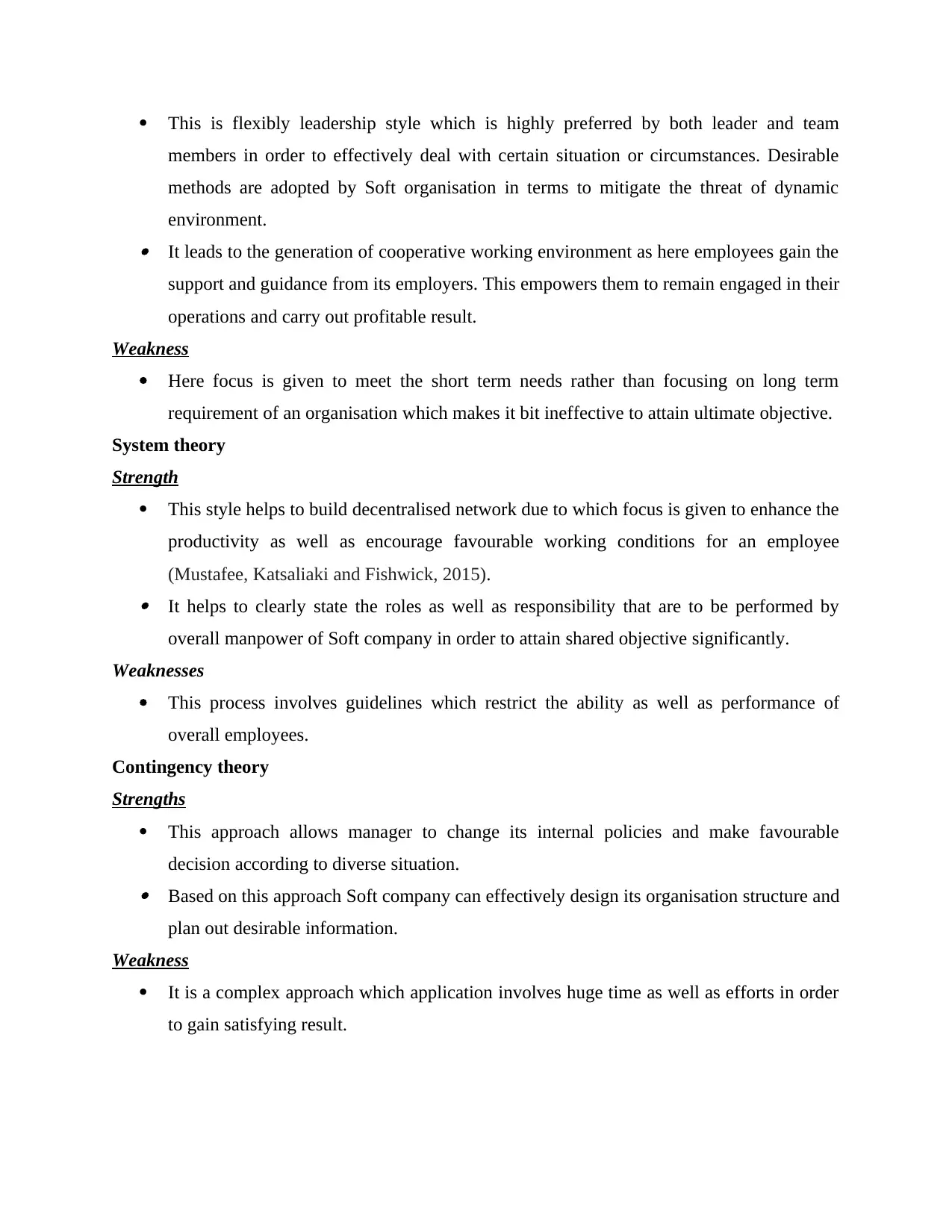
This is flexibly leadership style which is highly preferred by both leader and team
members in order to effectively deal with certain situation or circumstances. Desirable
methods are adopted by Soft organisation in terms to mitigate the threat of dynamic
environment. It leads to the generation of cooperative working environment as here employees gain the
support and guidance from its employers. This empowers them to remain engaged in their
operations and carry out profitable result.
Weakness
Here focus is given to meet the short term needs rather than focusing on long term
requirement of an organisation which makes it bit ineffective to attain ultimate objective.
System theory
Strength
This style helps to build decentralised network due to which focus is given to enhance the
productivity as well as encourage favourable working conditions for an employee
(Mustafee, Katsaliaki and Fishwick, 2015). It helps to clearly state the roles as well as responsibility that are to be performed by
overall manpower of Soft company in order to attain shared objective significantly.
Weaknesses
This process involves guidelines which restrict the ability as well as performance of
overall employees.
Contingency theory
Strengths
This approach allows manager to change its internal policies and make favourable
decision according to diverse situation. Based on this approach Soft company can effectively design its organisation structure and
plan out desirable information.
Weakness
It is a complex approach which application involves huge time as well as efforts in order
to gain satisfying result.
members in order to effectively deal with certain situation or circumstances. Desirable
methods are adopted by Soft organisation in terms to mitigate the threat of dynamic
environment. It leads to the generation of cooperative working environment as here employees gain the
support and guidance from its employers. This empowers them to remain engaged in their
operations and carry out profitable result.
Weakness
Here focus is given to meet the short term needs rather than focusing on long term
requirement of an organisation which makes it bit ineffective to attain ultimate objective.
System theory
Strength
This style helps to build decentralised network due to which focus is given to enhance the
productivity as well as encourage favourable working conditions for an employee
(Mustafee, Katsaliaki and Fishwick, 2015). It helps to clearly state the roles as well as responsibility that are to be performed by
overall manpower of Soft company in order to attain shared objective significantly.
Weaknesses
This process involves guidelines which restrict the ability as well as performance of
overall employees.
Contingency theory
Strengths
This approach allows manager to change its internal policies and make favourable
decision according to diverse situation. Based on this approach Soft company can effectively design its organisation structure and
plan out desirable information.
Weakness
It is a complex approach which application involves huge time as well as efforts in order
to gain satisfying result.
⊘ This is a preview!⊘
Do you want full access?
Subscribe today to unlock all pages.

Trusted by 1+ million students worldwide
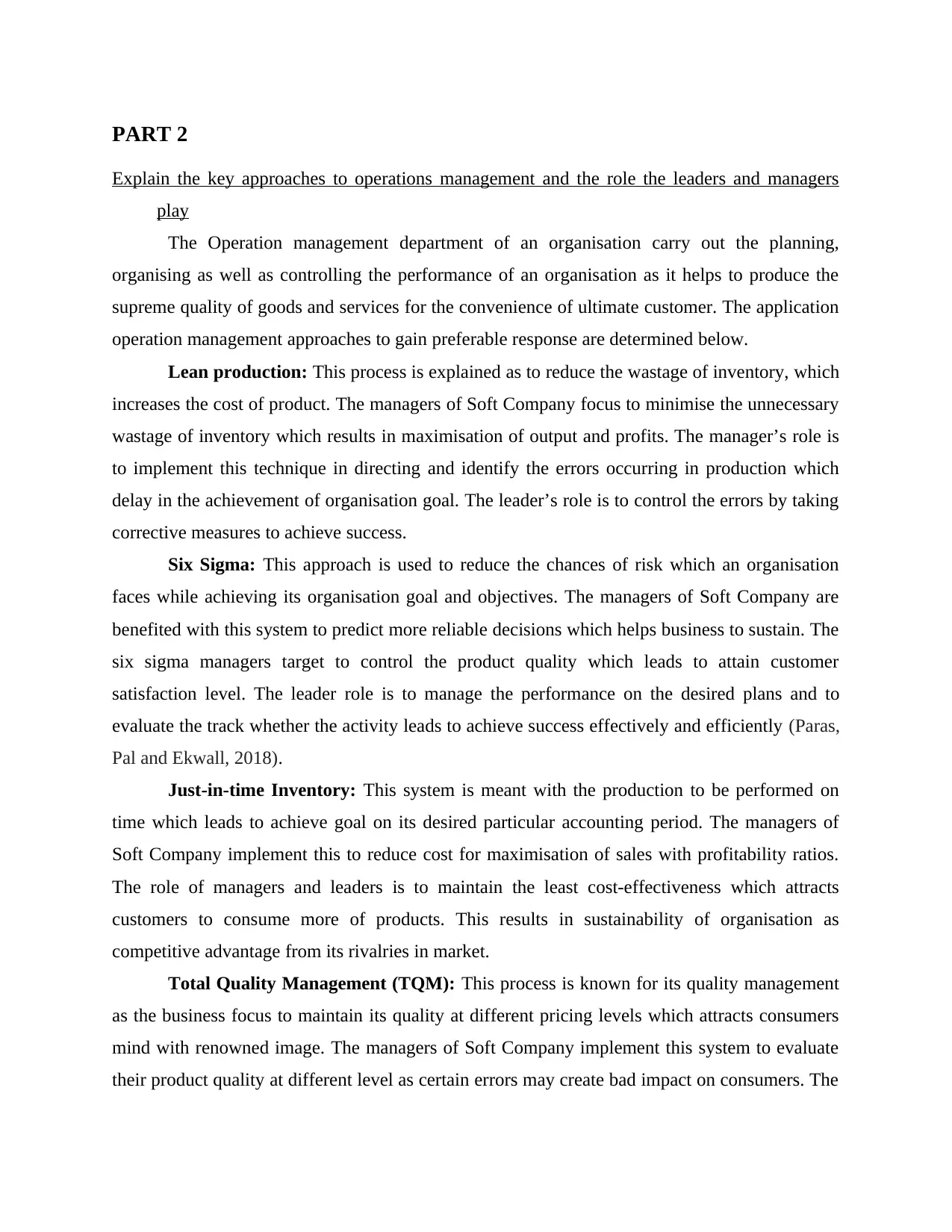
PART 2
Explain the key approaches to operations management and the role the leaders and managers
play
The Operation management department of an organisation carry out the planning,
organising as well as controlling the performance of an organisation as it helps to produce the
supreme quality of goods and services for the convenience of ultimate customer. The application
operation management approaches to gain preferable response are determined below.
Lean production: This process is explained as to reduce the wastage of inventory, which
increases the cost of product. The managers of Soft Company focus to minimise the unnecessary
wastage of inventory which results in maximisation of output and profits. The manager’s role is
to implement this technique in directing and identify the errors occurring in production which
delay in the achievement of organisation goal. The leader’s role is to control the errors by taking
corrective measures to achieve success.
Six Sigma: This approach is used to reduce the chances of risk which an organisation
faces while achieving its organisation goal and objectives. The managers of Soft Company are
benefited with this system to predict more reliable decisions which helps business to sustain. The
six sigma managers target to control the product quality which leads to attain customer
satisfaction level. The leader role is to manage the performance on the desired plans and to
evaluate the track whether the activity leads to achieve success effectively and efficiently (Paras,
Pal and Ekwall, 2018).
Just-in-time Inventory: This system is meant with the production to be performed on
time which leads to achieve goal on its desired particular accounting period. The managers of
Soft Company implement this to reduce cost for maximisation of sales with profitability ratios.
The role of managers and leaders is to maintain the least cost-effectiveness which attracts
customers to consume more of products. This results in sustainability of organisation as
competitive advantage from its rivalries in market.
Total Quality Management (TQM): This process is known for its quality management
as the business focus to maintain its quality at different pricing levels which attracts consumers
mind with renowned image. The managers of Soft Company implement this system to evaluate
their product quality at different level as certain errors may create bad impact on consumers. The
Explain the key approaches to operations management and the role the leaders and managers
play
The Operation management department of an organisation carry out the planning,
organising as well as controlling the performance of an organisation as it helps to produce the
supreme quality of goods and services for the convenience of ultimate customer. The application
operation management approaches to gain preferable response are determined below.
Lean production: This process is explained as to reduce the wastage of inventory, which
increases the cost of product. The managers of Soft Company focus to minimise the unnecessary
wastage of inventory which results in maximisation of output and profits. The manager’s role is
to implement this technique in directing and identify the errors occurring in production which
delay in the achievement of organisation goal. The leader’s role is to control the errors by taking
corrective measures to achieve success.
Six Sigma: This approach is used to reduce the chances of risk which an organisation
faces while achieving its organisation goal and objectives. The managers of Soft Company are
benefited with this system to predict more reliable decisions which helps business to sustain. The
six sigma managers target to control the product quality which leads to attain customer
satisfaction level. The leader role is to manage the performance on the desired plans and to
evaluate the track whether the activity leads to achieve success effectively and efficiently (Paras,
Pal and Ekwall, 2018).
Just-in-time Inventory: This system is meant with the production to be performed on
time which leads to achieve goal on its desired particular accounting period. The managers of
Soft Company implement this to reduce cost for maximisation of sales with profitability ratios.
The role of managers and leaders is to maintain the least cost-effectiveness which attracts
customers to consume more of products. This results in sustainability of organisation as
competitive advantage from its rivalries in market.
Total Quality Management (TQM): This process is known for its quality management
as the business focus to maintain its quality at different pricing levels which attracts consumers
mind with renowned image. The managers of Soft Company implement this system to evaluate
their product quality at different level as certain errors may create bad impact on consumers. The
Paraphrase This Document
Need a fresh take? Get an instant paraphrase of this document with our AI Paraphraser
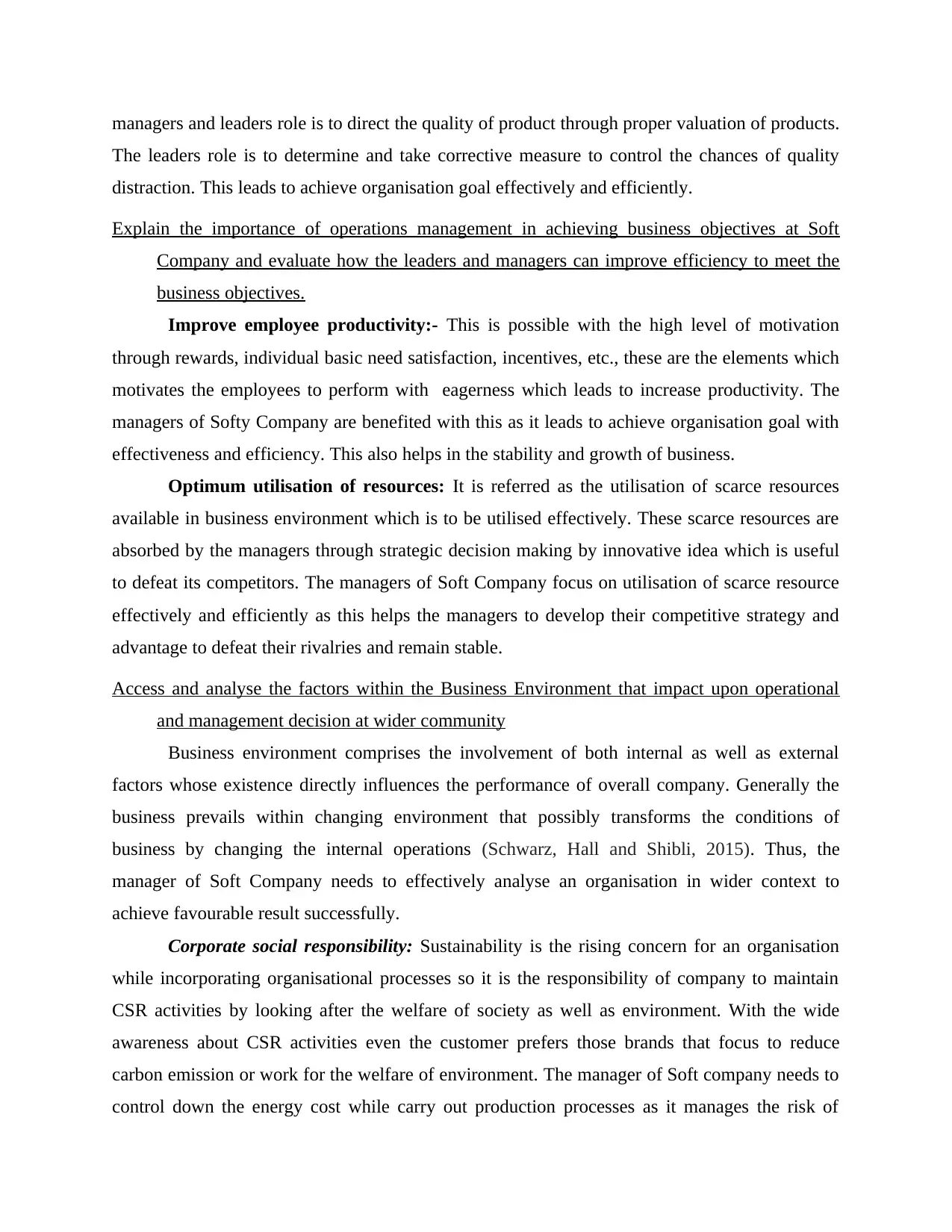
managers and leaders role is to direct the quality of product through proper valuation of products.
The leaders role is to determine and take corrective measure to control the chances of quality
distraction. This leads to achieve organisation goal effectively and efficiently.
Explain the importance of operations management in achieving business objectives at Soft
Company and evaluate how the leaders and managers can improve efficiency to meet the
business objectives.
Improve employee productivity:- This is possible with the high level of motivation
through rewards, individual basic need satisfaction, incentives, etc., these are the elements which
motivates the employees to perform with eagerness which leads to increase productivity. The
managers of Softy Company are benefited with this as it leads to achieve organisation goal with
effectiveness and efficiency. This also helps in the stability and growth of business.
Optimum utilisation of resources: It is referred as the utilisation of scarce resources
available in business environment which is to be utilised effectively. These scarce resources are
absorbed by the managers through strategic decision making by innovative idea which is useful
to defeat its competitors. The managers of Soft Company focus on utilisation of scarce resource
effectively and efficiently as this helps the managers to develop their competitive strategy and
advantage to defeat their rivalries and remain stable.
Access and analyse the factors within the Business Environment that impact upon operational
and management decision at wider community
Business environment comprises the involvement of both internal as well as external
factors whose existence directly influences the performance of overall company. Generally the
business prevails within changing environment that possibly transforms the conditions of
business by changing the internal operations (Schwarz, Hall and Shibli, 2015). Thus, the
manager of Soft Company needs to effectively analyse an organisation in wider context to
achieve favourable result successfully.
Corporate social responsibility: Sustainability is the rising concern for an organisation
while incorporating organisational processes so it is the responsibility of company to maintain
CSR activities by looking after the welfare of society as well as environment. With the wide
awareness about CSR activities even the customer prefers those brands that focus to reduce
carbon emission or work for the welfare of environment. The manager of Soft company needs to
control down the energy cost while carry out production processes as it manages the risk of
The leaders role is to determine and take corrective measure to control the chances of quality
distraction. This leads to achieve organisation goal effectively and efficiently.
Explain the importance of operations management in achieving business objectives at Soft
Company and evaluate how the leaders and managers can improve efficiency to meet the
business objectives.
Improve employee productivity:- This is possible with the high level of motivation
through rewards, individual basic need satisfaction, incentives, etc., these are the elements which
motivates the employees to perform with eagerness which leads to increase productivity. The
managers of Softy Company are benefited with this as it leads to achieve organisation goal with
effectiveness and efficiency. This also helps in the stability and growth of business.
Optimum utilisation of resources: It is referred as the utilisation of scarce resources
available in business environment which is to be utilised effectively. These scarce resources are
absorbed by the managers through strategic decision making by innovative idea which is useful
to defeat its competitors. The managers of Soft Company focus on utilisation of scarce resource
effectively and efficiently as this helps the managers to develop their competitive strategy and
advantage to defeat their rivalries and remain stable.
Access and analyse the factors within the Business Environment that impact upon operational
and management decision at wider community
Business environment comprises the involvement of both internal as well as external
factors whose existence directly influences the performance of overall company. Generally the
business prevails within changing environment that possibly transforms the conditions of
business by changing the internal operations (Schwarz, Hall and Shibli, 2015). Thus, the
manager of Soft Company needs to effectively analyse an organisation in wider context to
achieve favourable result successfully.
Corporate social responsibility: Sustainability is the rising concern for an organisation
while incorporating organisational processes so it is the responsibility of company to maintain
CSR activities by looking after the welfare of society as well as environment. With the wide
awareness about CSR activities even the customer prefers those brands that focus to reduce
carbon emission or work for the welfare of environment. The manager of Soft company needs to
control down the energy cost while carry out production processes as it manages the risk of
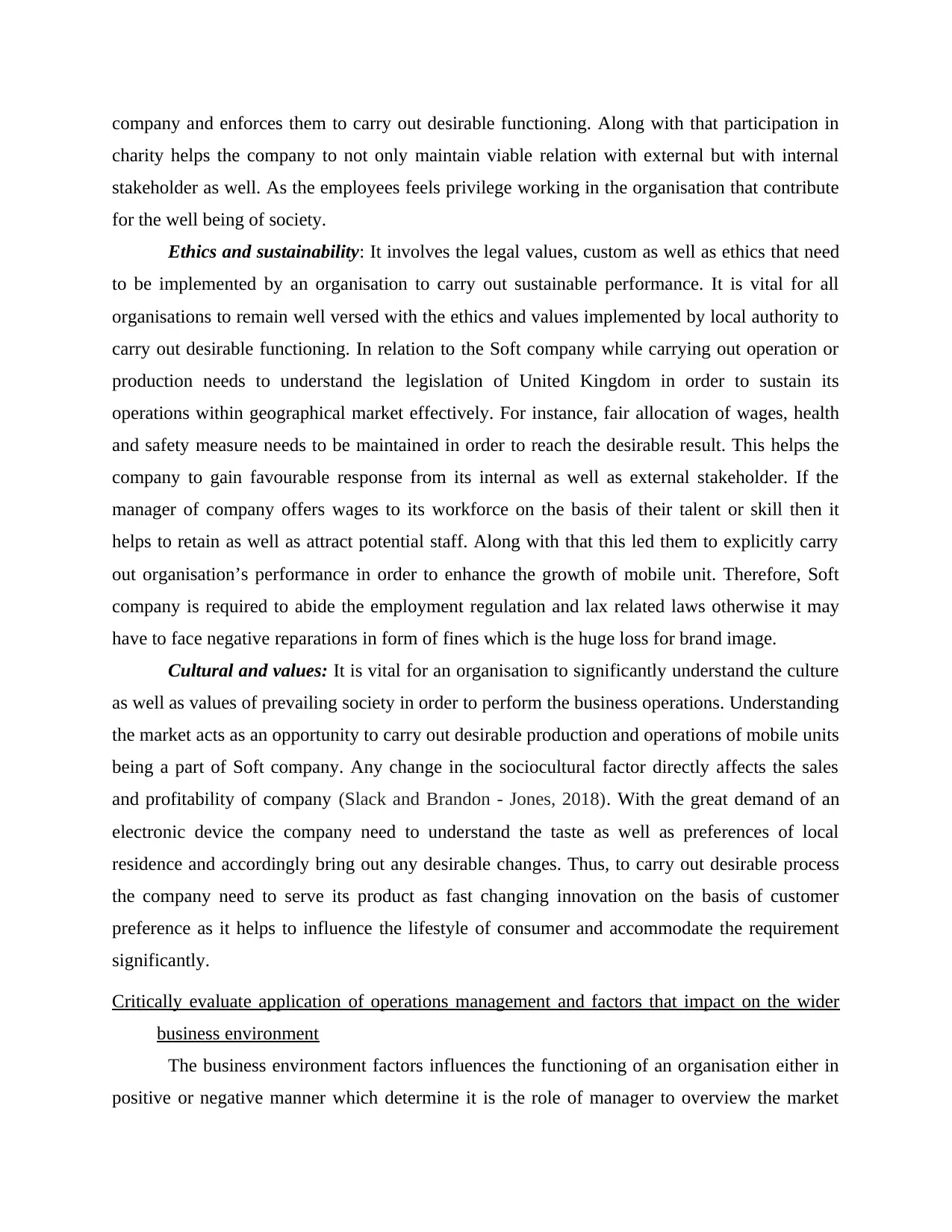
company and enforces them to carry out desirable functioning. Along with that participation in
charity helps the company to not only maintain viable relation with external but with internal
stakeholder as well. As the employees feels privilege working in the organisation that contribute
for the well being of society.
Ethics and sustainability: It involves the legal values, custom as well as ethics that need
to be implemented by an organisation to carry out sustainable performance. It is vital for all
organisations to remain well versed with the ethics and values implemented by local authority to
carry out desirable functioning. In relation to the Soft company while carrying out operation or
production needs to understand the legislation of United Kingdom in order to sustain its
operations within geographical market effectively. For instance, fair allocation of wages, health
and safety measure needs to be maintained in order to reach the desirable result. This helps the
company to gain favourable response from its internal as well as external stakeholder. If the
manager of company offers wages to its workforce on the basis of their talent or skill then it
helps to retain as well as attract potential staff. Along with that this led them to explicitly carry
out organisation’s performance in order to enhance the growth of mobile unit. Therefore, Soft
company is required to abide the employment regulation and lax related laws otherwise it may
have to face negative reparations in form of fines which is the huge loss for brand image.
Cultural and values: It is vital for an organisation to significantly understand the culture
as well as values of prevailing society in order to perform the business operations. Understanding
the market acts as an opportunity to carry out desirable production and operations of mobile units
being a part of Soft company. Any change in the sociocultural factor directly affects the sales
and profitability of company (Slack and Brandon - Jones, 2018). With the great demand of an
electronic device the company need to understand the taste as well as preferences of local
residence and accordingly bring out any desirable changes. Thus, to carry out desirable process
the company need to serve its product as fast changing innovation on the basis of customer
preference as it helps to influence the lifestyle of consumer and accommodate the requirement
significantly.
Critically evaluate application of operations management and factors that impact on the wider
business environment
The business environment factors influences the functioning of an organisation either in
positive or negative manner which determine it is the role of manager to overview the market
charity helps the company to not only maintain viable relation with external but with internal
stakeholder as well. As the employees feels privilege working in the organisation that contribute
for the well being of society.
Ethics and sustainability: It involves the legal values, custom as well as ethics that need
to be implemented by an organisation to carry out sustainable performance. It is vital for all
organisations to remain well versed with the ethics and values implemented by local authority to
carry out desirable functioning. In relation to the Soft company while carrying out operation or
production needs to understand the legislation of United Kingdom in order to sustain its
operations within geographical market effectively. For instance, fair allocation of wages, health
and safety measure needs to be maintained in order to reach the desirable result. This helps the
company to gain favourable response from its internal as well as external stakeholder. If the
manager of company offers wages to its workforce on the basis of their talent or skill then it
helps to retain as well as attract potential staff. Along with that this led them to explicitly carry
out organisation’s performance in order to enhance the growth of mobile unit. Therefore, Soft
company is required to abide the employment regulation and lax related laws otherwise it may
have to face negative reparations in form of fines which is the huge loss for brand image.
Cultural and values: It is vital for an organisation to significantly understand the culture
as well as values of prevailing society in order to perform the business operations. Understanding
the market acts as an opportunity to carry out desirable production and operations of mobile units
being a part of Soft company. Any change in the sociocultural factor directly affects the sales
and profitability of company (Slack and Brandon - Jones, 2018). With the great demand of an
electronic device the company need to understand the taste as well as preferences of local
residence and accordingly bring out any desirable changes. Thus, to carry out desirable process
the company need to serve its product as fast changing innovation on the basis of customer
preference as it helps to influence the lifestyle of consumer and accommodate the requirement
significantly.
Critically evaluate application of operations management and factors that impact on the wider
business environment
The business environment factors influences the functioning of an organisation either in
positive or negative manner which determine it is the role of manager to overview the market
⊘ This is a preview!⊘
Do you want full access?
Subscribe today to unlock all pages.

Trusted by 1+ million students worldwide
1 out of 15
Related Documents
Your All-in-One AI-Powered Toolkit for Academic Success.
+13062052269
info@desklib.com
Available 24*7 on WhatsApp / Email
![[object Object]](/_next/static/media/star-bottom.7253800d.svg)
Unlock your academic potential
Copyright © 2020–2025 A2Z Services. All Rights Reserved. Developed and managed by ZUCOL.



